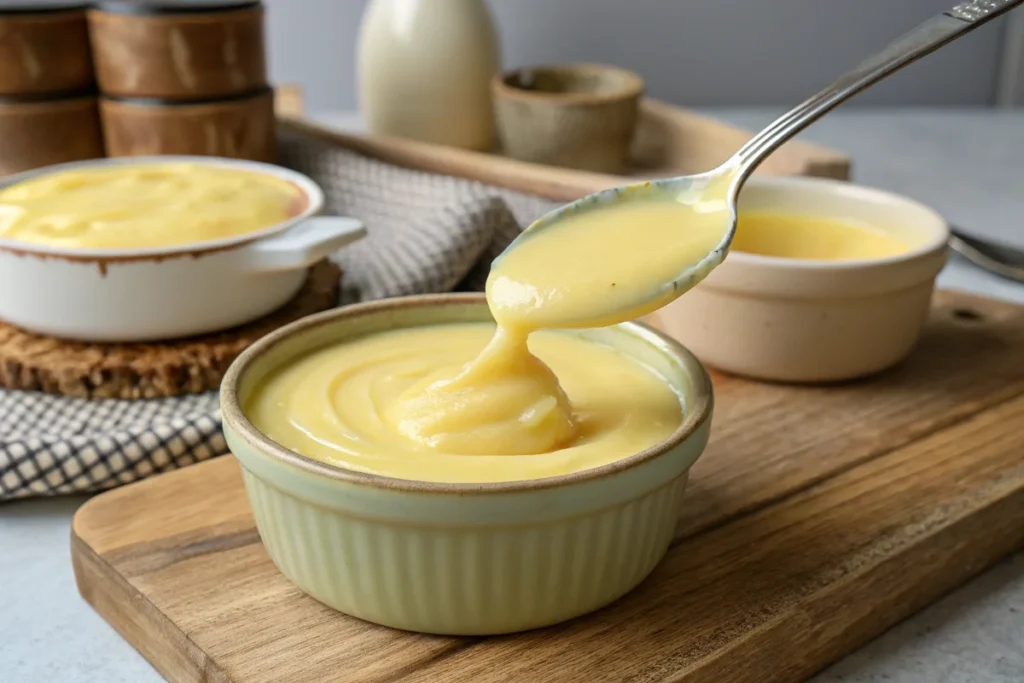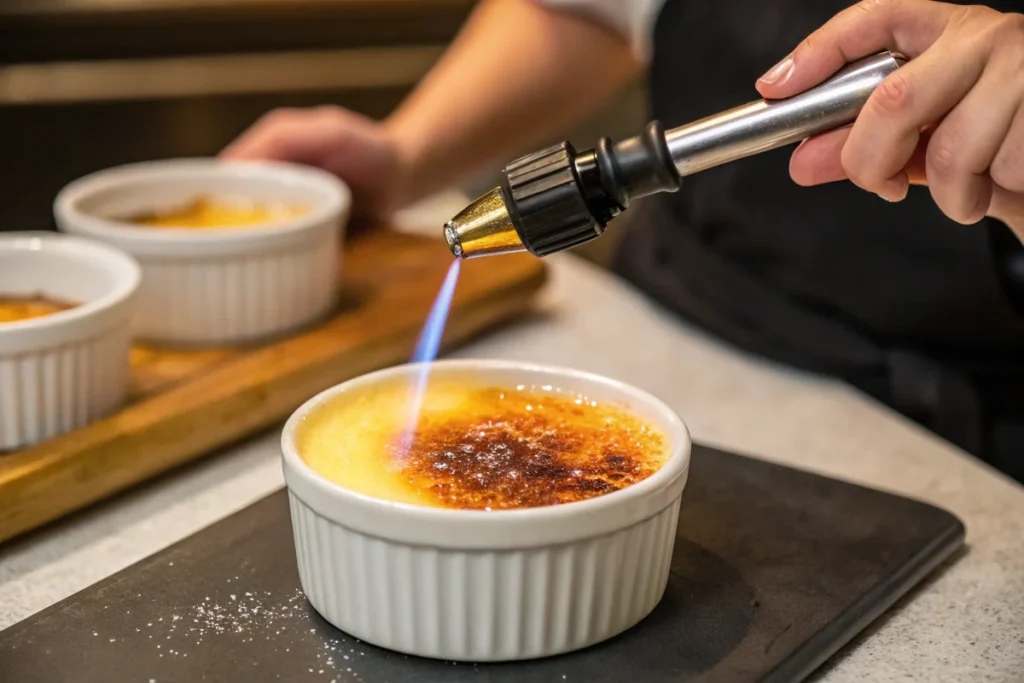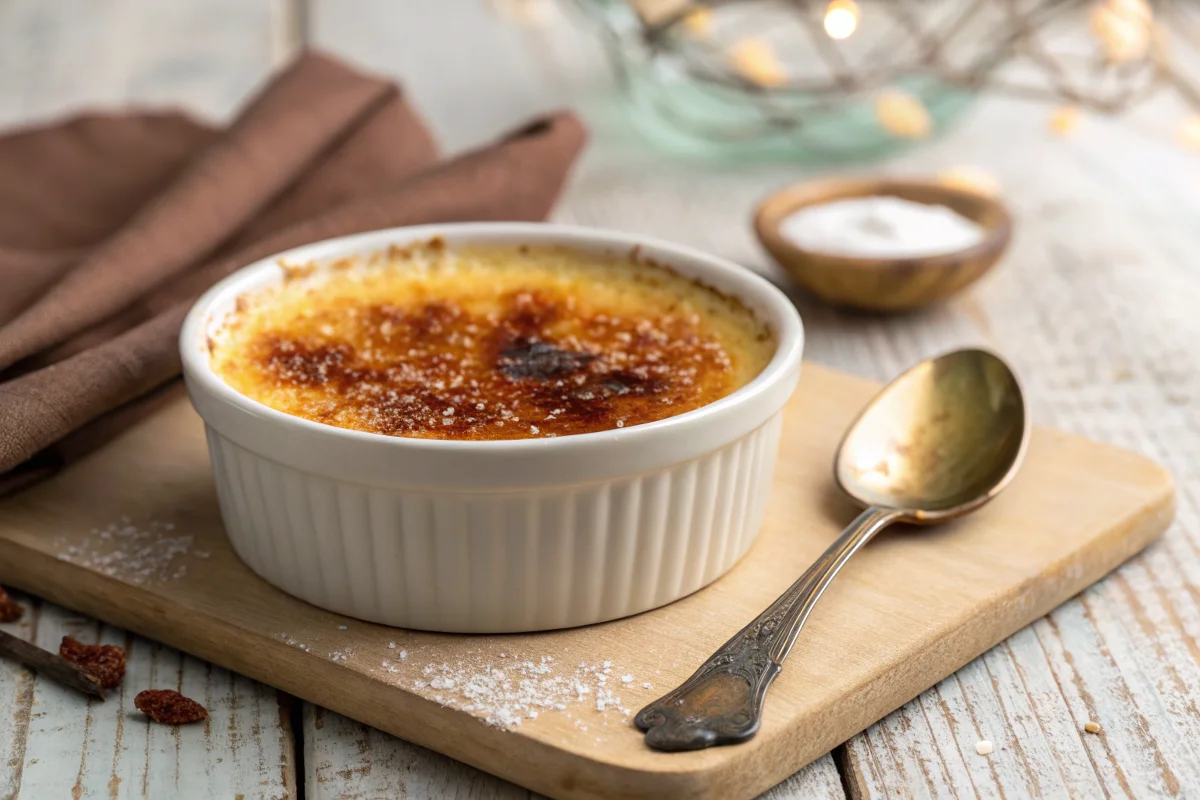A classic custard base forms the foundation for many sweet treats, but how does it compare to the famous Creme brulee? In this article, we’ll explore the differences between these two dishes, focusing on Creme brulee vs Custard.
Defining Custard: A Creamy Base
First, custard is a broad term. It refers to a cooked mixture. The base is typically milk or cream. Eggs or sometimes other thickeners are added. These components create a smooth, creamy texture. Therefore, custard serves as a base for many desserts. Additionally, custard can be prepared in various ways. It can be baked, stirred on the stovetop, or even steamed. Many people wonder about the Creme brulee vs Custard debate and this section will describe custard fully.

Understanding the Basics of Custard
Custard is not just a single recipe; it is a method. There are numerous variations. You will find it in puddings and tarts. For example, a simple custard might include just milk, eggs, and sugar. However, flavors such as vanilla or citrus zest can easily be added. Therefore, custard provides a flexible foundation for endless possibilities. It can be used hot or cold, making it incredibly versatile. Consequently, its use extends beyond desserts to savory dishes too. Custard, in its various forms, is a very common element, and this explanation is crucial when discussing Creme brulee vs Custard.
Key Characteristics of Custard
The texture of custard is key. It is usually silky smooth and creamy. This smooth texture arises from the egg proteins setting with heat. Moreover, custard should be thick enough to coat the back of a spoon. However, it shouldn’t be overly stiff or rubbery. The goal is a smooth, luscious mouthfeel. Therefore, proper cooking is critical to achieving the correct custard consistency. This difference in consistency is a good place to start when talking about Creme brulee vs Custard.
Creme brulee: A Type of Custard
Now, Creme brulee is a specific type of custard. It is a baked custard base. Therefore, it includes milk or cream, eggs, and sugar. Furthermore, it is distinguished by its hard, brittle sugar topping. This topping is caramelized using heat. Specifically, the top is torched or put under a broiler. When discussing Creme brulee vs Custard, this difference is very important.

Unique Aspects of Creme brulee
What sets Creme brulee apart is its signature crackling top, which is central to the dessert. It provides a contrast in texture, as the brittle sugar layer contrasts with the smooth custard underneath. Additionally, Creme brulee is usually served in individual ramekins, giving it a more formal and elegant feel. Consequently, Creme brulee is considered an elevated custard. When comparing Creme brulee vs custard, the texture is a key point.
Flavoring and Preparation of Creme brulee
The most traditional Creme brulee is flavored with vanilla, but you can add other flavorings. For instance, you can include citrus zest, coffee, or liqueurs. Furthermore, this dessert involves a two-step cooking process. First, bake the custard until set. Then, caramelize the sugar topping. Consequently, achieving Creme brulee’s iconic textures requires careful attention. This specific method defines Creme brulee and sets it apart from regular custard. The extra step is crucial in the Creme brulee vs custard discussion.
Creme brulee Versus Custard: The Key Differences
In short, all Creme brulee is a custard. However, not all custards are Creme brulee. Creme brulee is a more specific type of custard. Therefore, the core ingredients are similar, but the preparations are different. Moreover, the most obvious difference when comparing Creme brulee vs Custard is the hard sugar topping on the Creme brulee.
Preparation Techniques
You can cook custard in various ways. As mentioned, you can bake, steam, or cook it on the stovetop. In contrast, you always bake Creme brulee, specifically in individual ramekins. Additionally, you must caramelize the topping at the end. Therefore, the methods are not interchangeable. The preparation process is a key differentiator when discussing Creme brulee vs custard.
Texture and Presentation
The texture of custard varies based on preparation. It can be smooth like a sauce or firmer like pudding. However, Creme brulee always has a smooth, creamy custard base topped with a crisp, hardened caramelized sugar layer. Furthermore, custards can be served in many ways, while Creme brulee is typically served in individual dishes. As a result, the presentation of Creme brulee is more standardized. The differences in texture clearly set Creme brulee apart from regular custard, making this distinction vital when discussing Creme brulee vs custard.
Purpose and Usage
Custard can be used in many desserts. You can use it as a filling, sauce, or stand-alone dessert. On the other hand, Creme brulee is a specific dessert in itself. Therefore, custard plays a more flexible role, while Creme brulee is more defined. This means that although Creme brulee is a form of custard, you cannot use it in as many ways as regular custard. Understanding the uses of custard versus Creme brulee highlights their differences, which is important when comparing Creme brulee and custard.
Understanding the Role of Eggs
Eggs are critical in both custard and Creme brulee. The yolks provide richness and thickening power. Moreover, they help set the base with heat. However, the number of yolks and whites can change the texture. For example, custard made with more yolks will be richer. Similarly, custard with more whites will be lighter. Therefore, knowing the roles of egg parts is key to achieving the desired result.
Achieving the Right Consistency
Both custard and Creme brulee need proper cooking. If not, the texture can be compromised. For example, overcooking results in a rubbery custard. Under-cooking causes it to be runny. Therefore, careful heat control is essential. This ensures the custard base is perfectly smooth and creamy. Consequently, cooking skills will directly impact the quality of the dessert, whether making custard or Creme brulee. This is an important note when thinking about the differences of Creme brulee vs Custard.
The Importance of Technique
Technique is paramount when making custard. Whether you are using a stovetop or oven, attention to detail is necessary. However, when preparing Creme brulee, the caramelization is crucial. Therefore, the application of heat must be precise. The sugar should melt evenly. It should form a smooth, brittle layer. Consequently, each stage requires practice and knowledge to avoid a bad outcome for both custard and Creme brulee. Understanding this will help anyone wanting to know the difference between Creme brulee vs Custard.
Custard in the Culinary World
Beyond Creme brulee, many other dishes use custard. Examples include pastry cream, ice cream bases, and flans. Furthermore, cooks use it in savory dishes like quiche. Therefore, understanding custard is essential for any cook. Moreover, you can combine it with fruit, chocolate, or spices to create endless flavor possibilities. Consequently, custard serves as a foundational element of many recipes. This shows how common custard is compared to Creme brulee.
Exploring Variations of Custard
Different cultures have their own custard variations. Each version uses different techniques and flavorings. For example, some custards include cornstarch as a thickener. Others may use gelatin. Therefore, different ingredients result in varied textures. Subsequently, this highlights the versatile nature of custard. This shows the range when talking about Creme brulee vs Custard.
The Wide Application of Custard
Custard appears in both simple and complex recipes. It works just as well in a comforting bread pudding as it does in a complex layered cake. This flexibility highlights its universal appeal and demonstrates the broad usefulness of mastering custard preparation. Ultimately, this makes custard a highly valuable skill in the kitchen. The many uses for custard set it apart from Creme brulee, emphasizing the key differences when considering Creme brulee vs custard.
Making Creme brulee at Home
Making Creme brulee at home is achievable, but it requires careful planning. First, prepare the custard base. Second, bake it in ramekins. Third, let it cool down completely. Fourth, add the sugar on top. Finally, caramelize the top with a torch or broiler. Therefore, the process is simple but requires precision. This detailed preparation distinguishes Creme brulee from simple custard. It is an important factor to consider in the Creme brulee vs Custard analysis.

Tips for Perfect Creme brulee
Use high-quality ingredients for best results. Specifically, fresh, good quality cream and eggs make a difference. Additionally, ensure even baking to avoid a curdled custard. Furthermore, when caramelizing, keep the torch moving. This helps prevent scorching the sugar. Consequently, patience and attention to detail will give you a perfect Creme brulee. Taking these steps helps to perfect the process of making Creme brulee.
Serving Creme brulee
You typically serve Creme brulee immediately after caramelizing the topping. However, you can make the custard base in advance. Moreover, the contrasting temperatures add to the appeal. The cold custard and warm, brittle topping create a unique sensation. Finally, serve this classic dessert in style for a memorable experience. Serving Creme brulee offers a delightful treat, different from just a simple custard.
In Conclusion: Custard and Creme brulee
To summarize, custard is a broad category of creamy desserts. Creme brulee, however, is a specific type of baked custard. It stands out due to its signature caramelized sugar topping. Although both desserts use similar core ingredients, their preparation and final presentation differ significantly. Understanding the key differences between these two delicious treats enhances your appreciation for both. The main difference between Creme brulee and custard is the signature topping, and recognizing this difference makes you a better baker. For a great recipe to try, check out this creme brulee recipe.


1 thought on “Creme brulee vs Custard: What’s the Difference?”